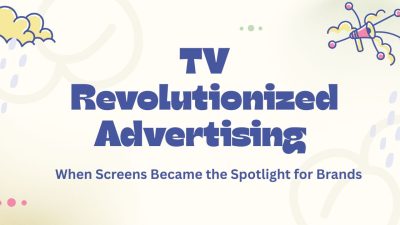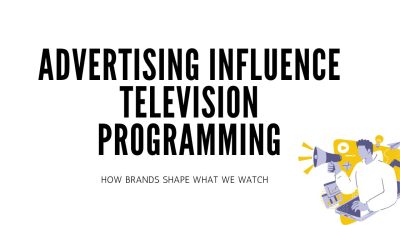There’s more than just commercial breaks that link advertising with television programming. What shows are made, how content is conceived, and what stories can be told have always been subject to the whims of advertisers since the small screen’s earliest days. (The two-thousand-year-old interaction has been an essential part of what the medium is today.)
Learning about how advertising has shaped television programming provides vital lessons in media economics, audience response, and content development. From the early single-sponsor days to present-day multi-platform strategies, advertising dollars have always been the controller behind programming changes that affect millions of viewers in America and around the world.
The Golden Age: Sponsors Were in Charge of Everything
Television programming originated with a minimalist model: single sponsors paid for entire shows and exercised unfettered creative control. Outfits like Texaco, General Electric, and Kraft didn’t just purchase time to advertise on a show; they owned the shows.
This model spawned television programs like “Texaco Star Theater” and “The General Electric Theater,” on which sponsors weaved promotional messaging directly into content. Milton Berle was Mr. Texaco, and Ronald Reagan was the host of GE’s anthology series, the bridge to an entertainment/brand promotion hybrid.
Editorial Control and Content Restrictions
Sponsors commanded unusual control over plots, including who won roles, and even what lines the actors could say. They might request script alterations or remove characters from a show, block controversial topics, or simply kill shows if the content did not match their brand image.
This control created sanitized programming that did not touch controversial topics. Politics, social concerns, or anything controversial that could potentially alienate its customers was conventionally left out of the small screen.
This influence was illustrated by the notorious “Camel News Caravan”. The tobacco company banned the shooting of “No Smoking” signs and insisted that competitive products never make it on screen. Those restrictions influenced news and documentary coverage for decades.
The Multi-Sponsor Revolution
With the number of television viewers on the rise, so, too, were the costs of advertising beyond the ability of potential single sponsors. The business moved toward the various multi-sponsor plans where several advertisers would underwrite the cost of a program, completely altering the manner in which shows were produced.
This shift removed sponsors’ direct editorial control and instead imposed new forms of moral suasion. Programs had to appeal to wider audiences to command higher ad rates, which resulted in more generic offerings that were offensive to no one.
The Rise of Ratings-Driven Programming
Parasitical multi-sponsor advertising begat an obsession with audience measurement that still kills original thought. Shows rose or fell based on their power to deliver specific demographic slices to advertisers, not necessarily on their artistic value or cultural relevancy.
Such a focus on ratings resulted in programming being made without any concern for public service value. Educational content, niche interests, and experimental formats simply couldn’t survive unless they could promise big-time viewership.

Commercial Interruption Reinforces Content Flow Structure
The requirement for regular commercial breaks utterly transformed the way that stories on television were presented. Writers had to write their stories around these interruptions, fabricating hooks and cliffhangers to keep viewers interested for commercial breaks.
This commercial format impacted the pacing, characterization, and narrative structures of all television. Newsmen invented segment-based programming, dramatists wrote for act breaks, and variety programmers scheduled show business within commercial strictures.
The 22-Minute Episode Standard
It was commercial television that created the standard 22-minute half-hour format, with eight minutes set aside for commercials. This limitation caused a context in which writers had to create efficient ways of telling stories, achieving the most with as little time as possible.
Hourlong dramas fit this structure of 42 minutes of content and 18 minutes of commercials. These time restrictions were so deeply ingrained that they had a direct effect on programming, even on stations supported by no commercials.
Demographics Drive Programming Decisions
It was advertisers’ targeting of certain demographics that had a profound effect on what kinds of shows actually got made. The dearest demographic, the 18- to 49-year-olds, was made king, and shows that were drab to them, which invariably meant cancellation.
This ageist targeting meant that there were gaps in programming for older viewers and children, and minority groups who did not match advertiser priorities. It was difficult to attract funding for shows catering to these audiences, even though they had loyal viewership’s.
The “Least Objectionable Programming” Philosophy
The networks used tactics to attempt to keep away viewers from turning off television sets abruptly, but universally; potentially turning away fickle viewers was the primary concern. This translated into programming that attempted to offend no one and was thus gibberish.
Sensations and controversial topics were bad for business. A programs that might get people talking or face new perspectives were systematically discouraged in favor of the safe options.
Product Placement Integration Transforms Content
Emerging around the time that more than a decade of DVR viewership led people to skip traditional ads, it represents a more integrated way for advertisers to connect with consumers. It’s gone from brief background cameos to essential plotlines that can’t be bypassed.
This fusion influenced the way props, locations, and even storylines were conceived. There were writers whose job it was to work specific products seamlessly into their scripts, production designers who were tasked with making sure branded merchandise was shown prominently in a scene.
Storyline Advertising and Branded Content
Some shows started constructing entire episodes around advertiser products. Characters would reference brand names, cite specific stores, or make consumption of featured products a focal point of the narrative.
This method muddled the distinction between entertainment and advertising, producing programming that was driven by commerce but still appeared to be independent.
Cable Television and Niche Programming
The increasing reach and influence of cable television, a growing advertising market, opened up new possibilities in programming choices. In an environment with hundreds of channels vying for attention, networks could cater to special demographics with tailor-made programming for that audience.
This schism led to greater diversity of programming as advertisers were eager to provide spots to target groups of viewers. “We’d produce content and shows that were specifically created to get advertisers who wanted the audience that that channel could provide.
Subscription Models Reduce Advertising Dependence
Premium cable channels, such as HBO and Showtime, forged a subscriber model that lowered their reliance on advertising sales. The freedom allowed for experimental programming formats, as well as brash and often controversial content.
The victory of ad-free programs showed that good content could pull in an audience without the support of commercials, but also changed how other networks viewed programming choices.
Digital Disruption and Streaming Services
All of this is upending the traditional relationship between advertising and programming on streaming platforms. Netflix, Amazon Prime, and Disney+ originally ran advertising-free, untethered from traditional commercial limitations.
This advertising-free model empowered streaming services to try out episode lengths, narrative structures, and content that perhaps would not thrive in a traditional television environment. Bingeing was made possible because shows no longer had to fit into the 24-minute structure that commercial breaks required.
Data-Driven Programming Decisions
On streaming platforms, programming choices are informed by viewer data rather than the demands of advertisers. This methodology has resulted in a greater range of content offered as platforms aim to cater for niche audience interests rather than for mass market demographics.
The nature of niche programming’s success in streaming services has led traditional television to think its role in creating content as well as targeting the audience it reaches.
Interactive Advertising and Shoppable Content
Cutting-edge tech now makes it possible for commercials to be interactive with everything from show content. Viewers can click on items in shows to learn more or make purchases, opening a new revenue stream for content creators.
This interactivity is shifting the way that programs are made, with creators factoring in business potential at the development stage. Costumes, set design, and prop selection are increasingly being influenced by the potential for advertising value.
Real-Time Advertising Optimization
Sophisticated analytics that allow advertisers to tweak their strategy based on real-time viewer response. This power affects the types of programming the networks choose to produce to attract the most advertising.
The programs that will encourage viewer interactivity or social media engagement will increasingly be worth more to advertisers, which will affect what kinds of content get produced and promoted.

The Resurgence of Advertising-Supported Streaming
To bolster revenues, many streamers have slotted in ad-supported tiers that have once brought the commercial calculus right back into programming decisions. This new iteration of advertising influence within content, it seems, would return to interpretation three: “Advertising influence back again over content, replaced at the latest in new versions.”
Ad-supported streaming brings its own set of pressures compared with traditional television advertising. Viewers are in charge of their viewing experience, driving advertisers to come up with more engaging, less intrusive content.
Personalized Advertising and Content Recommendations
The bank of choice is also able to offer personal advertising based on the individual viewer’s taste and behavior. This ability also affects programming, and as channels fit the content to those that target specific advertiser interests.
The content-targeting capability of content-and-advertising matching also opens up new prospects for niche programming to be viable economically.
Building a Better TV Show Through the Study of Advertising
“HBO, Circa 2003, Before Everyone Had DVR”: Advertising’s Ever-Widening Gap Between Content and TV The dynamic between advertising and what we watch on TV is a constantly moving target as advances in technology offer content creators and advertisers new opportunities Index Exchange Kristintern Follow Jul 17, 2019 · 1 min read The TV commercial break is no longer what it once was. Understanding these relationships empowers viewers to make decisions informed by their media consumption and to also support content that is in alignment with their beliefs.
The most effective TV-making is now a matter of balancing artistic vision with commercial need. The best solutions will acknowledge advertising’s place and serve creator and user alike well while staying true to the craft.
When the creators know that they are a powerful vector of advertising, they can make strategic choices about what type of funding, distribution, and audience targeting best serve their larger creative vision. And that knowledge allows us to make better programming decisions that achieve both commercial and artistic goals, at the same time.
Advertising hasn’t just supported television—it’s redefined how shows are created, timed, and monetized. As media strategies evolve, many businesses are also adopting new approaches to innovation and customer engagement. For a deeper look into applying creative problem-solving to your own marketing, explore our article on Revolutionize Your Business With a Design Thinking Marketing Strategy.





